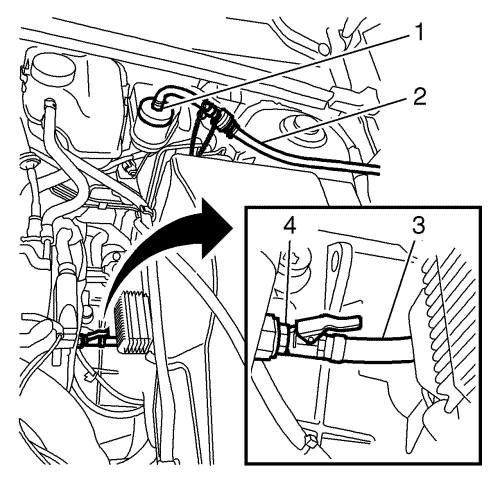Hydraulic Clutch System Bleeding
Special Tools
DT-6174-A Connecting Hose Set
For equivalent regional tools, refer to Special Tools .
Procedure
Warning: Refer to Brake Fluid Irritant Warning in the Preface section.
Warning: When adding fluid to the brake fluid reservoir or to the clutch fluid reservoir, use only DOT-4+ brake fluid from a clean, sealed container. This polyglycol brake fluid is hygroscopic and absorbs moisture. Do not use fluid from an open container that may be contaminated with water. Brake fluid must not be contaminated with mineral oil. Improper or contaminated fluid could result in system failure, loss of vehicle control, and possible injury. Complaints because of, or defects caused by contaminated brake fluid will not be accepted by GM warranty.
Caution: Refer to Brake Fluid Effects on Paint and Electrical Components Caution in the Preface section.
Note: Only use brake fluid DOT 4+. The hydraulic clutch actuation must now only be bled from "below", i.e. from the bleeder valve. A brake bleeder must be used for this purpose - see " Workshop Equipment" catalogue. Manual bleeding is no longer permissible. Observe manufacturer's instructions before using brake bleeder. The brake bleeder must be set to an operating pressure of approximately 2 bar.

- Attach brake bleeder.
| • | Screw adapter (1) for corresponding brake bleeder onto brake fluid reservoir. |
| | Note: Insert hose end in suitable brake fluid collecting basin. |
| • | Connect DT-6174-A set (2) to adapter. |
| • | Disconnect valve cap from bleeder valve. |
| • | Connect DT-6174-A connecting hose set (3) to bleeder valve (4). |
| • | Connect DT-6174-A set to brake bleeder. |
- Bleed clutch.
| • | Switch on brake bleeder. |
| • | Open bleeder valve 2-3 turns. |
| • | Bleed until brake fluid escapes without bubbles at DT-6174-A set. |
| • | Close bleeder valve hand tight. |
- Detach brake bleeder.
| • | Detach adapter from brake fluid reservoir. |
| • | Push valve cap onto bleeder valve to protect the bleeder valve. |
| | Note: The following operational stages must be undertaken to fill the pressure line between the transmission housing and the central release. When bleeding, ensure that the brake fluid reservoir is always filled up sufficiently and does not run dry. |
- Bleed pressure line between transmission housing and central release.
| • | Press and hold clutch pedal. |
| • | Open bleeder valve until air or air/brake fluid mixture emerges. |
| • | Close bleeder valve hand tight. |
| | Note: Do not close the bleeder valve too fast. |
| • | Release clutch pedal as far as the stop at normal speed. |
| • | Wait approximately 5 seconds. |
| • | Repeat this bleeding process 4 times. |
| • | Push valve cap on to bleeder valve to protect the bleeder valve. |
- Connect DT-6174-A set to bleeder valve, place free end in a suitable connecting container.
- Top up brake fluid reservoir.
| • | Fill brake fluid reservoir up to "MAX" marking. |
| • | Install brake fluid reservoir. |
- Check actuation pressure of clutch pedal.
- Check shifting for ease of movement with vehicle stationary, with engine running and with clutch disengaged.
- Road test the vehicle to ensure proper operation.
Undertake road test using varying RPM ranges and frequent gear changes, bring vehicle to operating temperature during this process. Ensure the brake and clutch system is operating correctly.
| © Copyright Chevrolet. All rights reserved |
| © Copyright Chevrolet. All rights reserved |
